History of Canada's Food Guides from 1942 to 2007
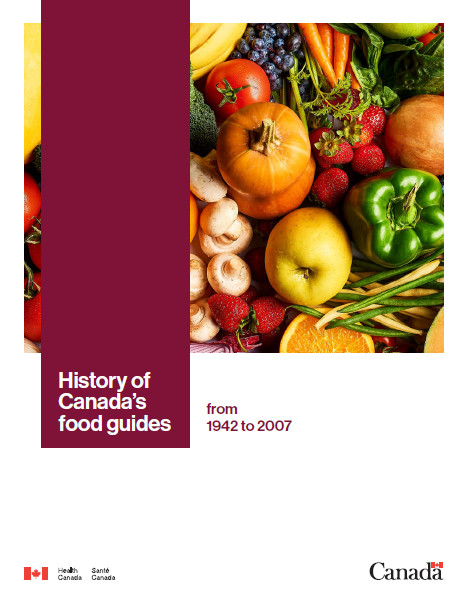
Download the alternative format
(PDF format, 4100 K)
Organization: Health Canada
Published: 2019-01-22
Table of contents
- Introduction
- 1942 Canada's Official Food Rules
- 1944 Canada's Food Rules
- 1949 Canada's Food Rules
- 1961 Canada's Food Guide
- 1977 Canada's Food Guide
- 1982 Canada's Food Guide
- 1992 Canada's Food Guide to Healthy Eating
- 2007 Eating Well with Canada's Food Guide
- Eating Well with Canada’s Food Guide – First Nations, Inuit and Métis
- Conclusion
- References
Introduction
Canada's first food guide, the Official Food Rules, was introduced to the public in July 1942. This guide acknowledged wartime food rationing, while endeavoring to prevent nutritional deficiencies and to improve the health of Canadians. Since 1942, the food guide has been transformed many times - it has adopted new names, new looks, and new messages, yet has never wavered from its original purpose of guiding food selection and promoting the nutritional health of Canadians.
Role of food guides
Food guides are basic education tools that are designed to help people follow a healthy diet. They embody sophisticated dietary analysis, and merge national nutrition goals, data from food consumption surveys, and issues of food supply and production. They translate the science of nutrient requirements into a practical pattern of food choices, incorporating variety and flexibility.
Process to develop the food guides
Little is recorded about the process used to develop the earliest food guides for Canada. We do know that they were developed by the Nutrition Division of the federal Department of Pensions and National Health. Further, the Canadian Council on Nutrition contributed to the development of the early food guides, with each publication from 1942 to 1961 displaying a statement declaring that the guide was "Approved by the Canadian Council on Nutrition". Appointed by the government in 1938 and remaining in existence until 1969, this group consisted of "scientists, medical experts, and welfare workers brought together from university departments, welfare and health organizations and the government, to discover, study and discuss nutritional problems of national and regional significance in Canada and to make recommendations as to their solution".Footnote 1
In addition to approving the food guides, the Council spearheaded the development of the first Dietary Standard for Canada (1938) and subsequent revisions to that Standard. Dietary Standards described "the amounts of essential nutrients considered adequate to meet the needs of practically all healthy persons".Footnote 2 These Standards were translated into foods and thus became part of the science that underpinned food guide recommendations.
We also know that the federal Nutrition Division linked with provincial counterparts, as it does today. In 1945, the Canadian Council on Nutrition established the Dominion Provincial Nutrition Committee, a group mandated to assist in the coordination and cooperation of nutrition activities between the provinces and the federal government. This enhanced communication between the front-line and enabled practitioners within the provinces to become a source of advice when revising the food guide. There is evidence that the Council did indeed listen to the requests of the practitioners. For example, in a discussion of the 1949 food guide revision, the Council credits one change to the suggestions of numerous doctors and nutritionists.Footnote 3
This kind of expert input has formed a fundamental part of all food guide revisions. Some revisions emerged from a small nucleus of people, who gathered input from others in informal, yet effective, ways. Today, the process is more structured, complex, and far-reaching, as evidenced by the most recent 2019 food guide revision. Many stakeholders were consulted to ensure that, in addition to the research being conducted, the views of a broad base of Food Guide users were considered.
Food guides then and now
The title of Canada's food guides has changed over time. Canada's Official Food Rules (1942) became Canada's Food Rules (1944, 1949), then Canada's Food Guide (1961, 1977, 1982). Canada's Food Guide to Healthy Eating (1992) evolved to Eating Well with Canada's Food Guide (2007). The title changes signify an evolution in the positioning and philosophy of the food guide. This report documents the processes and influences that shaped the development of Canada's food guides, the changes that occurred from the 1942 Official Food Rules to the 2007 Eating Well with Canada's Food Guide, and the strategies that were used to encourage Canadians to follow the guides.
1942 Canada's Official Food Rules
Canada at war cannot afford to ignore the power that is obtainable by eating the right foods.Footnote 4
Canada's Official Food Rules were developed by the Nutrition Division of the federal government in collaboration with the Canadian Council on Nutrition. Food consumption surveys, although limited at the time, revealed problems such as poor access to food, insufficient money for food, and malnutrition in some populations. Thus, the Official Food Rules were intended to be a focal point for a wartime nutrition program to improve the health of Canadians by maximizing nutrition in the context of food rationing and poverty.Footnote 1,Footnote 4,Footnote 5,Footnote 6,Footnote 7 The publication identified six food groups (Milk; Fruit; Vegetables; Cereals and Breads; Meat, Fish, etc.; and Eggs) for which specific amounts of foods were suggested for daily consumption. Limited supplies of certain foods, such as milk, prompted the Council to base the Food Rules on 70% of the Dietary Standard.Footnote 8 The foods listed in the Rules were considered to be "health-protective", a term we are more likely to associate with current nutrition debates.
Implementation
The resource support given in the 1940's to the promotion of healthy eating is impressive. In 1943, the Nutrition Division of the Department of Pensions and National Health launched the Canada Nutrition Program, which, among other tasks, handled public education on the new Food Rules. The Canada Nutrition Program was billed as a long-term and comprehensive approach to "help everyone in Canada toward the health that comes from eating the right foods".Footnote 4 To help people eat the right foods through the implementation of the Food Rules, the government enlisted many strategies. For instance, an extensive media campaign to encourage people to put the Food Rules into action used radio spots, weekly press releases, and articles in magazines. Print materials were used to reinforce the media messages; for example, materials included a one-page Score Sheet for One Day's Meals, six lesson plans for teachers called Healthful Eating, and a food shopping list series. A series of 10 leaflets, produced under the title Check Your War Efficiency and inserted into weekly pay envelopes, covered topics such as breakfast, lunch, and the role of milk in healthy eating. All materials were available in both French and English.Footnote 9
Canada's Official Food Rules - 1942
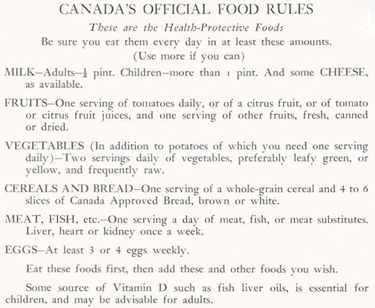
Text Description
This image lists the suggested foods to eat in Canada’s Official Food Rules. It states:
These are the health protective foods. Be sure to eat them every day in at least these amounts (use more if you can).
- MILK- Adults- ½ pint. Children- more than 1 pint. And some cheese as available.
- FRUITS- One serving of tomatoes daily, or of a citrus fruit, or of tomato or citrus fruit juices, and one serving of other fruits, fresh, canned or dried.
- VEGETABLES- (In addition to potatoes of which you need one serving daily) - Two servings daily of vegetables, preferably leafy green or yellow and frequently raw.
- CEREALS AND BREADS- one serving of a whole grain cereal and four to six slices of Canada Approved Bread, brown or white.
- MEAT, FISH, etc. - One serving a day of meat, fish, or meat substitutes. Liver, heart or kidney once a week.
- EGGS- at least 3 or 4 eggs weekly
Eat these foods first, then add these and other foods you wish.
Some source of vitamin D such as fish liver oils, is essential for children, and may be advisable for adults.
1944 Canada's Food Rules
The Food Rules should serve as a guide to the selection of foods which would provide the necessary nutrients from day to day.Footnote 10
In 1944, the Canadian Council on Nutrition approved Canada's Food Rules, removing the term "official". At this time, numerous changes to the content of the publication were made. The basis of the Rules shifted from 70% of the Dietary Standard as was the case in 1942 to a "fully adequate figure".11
In order to encourage Canadians to meet riboflavin requirements, the 1944 Rules advocated the consumption of a greater quantity of milk. However, the scarcity of milk that was evident at the time prompted the Department of Agriculture to object to this recommendation.Footnote 8 Other specific changes included replacing the term "substitute" with "alternate" in the Meat and Fish group to guard against misinterpretation. Also, due to a limited supply of kidney and heart, references to these meats were removed from the Meat and Fish group. However, due to its "distinct nutritional characteristics", liver was retained in the examples of foods.Footnote 10 Cheese and eggs were incorporated into the Meat and Fish group on the basis of their protein content. Butter was mentioned in the Bread and Cereals group. Further, a statement recommending the consumption of water and iodized salt was added to underline their importance in the Canadian diet.Footnote 8 Footnote 9 Footnote 11 Footnote 12
Implementation
A restricted federal budget meant finding creative ways to reach the Canadian public. Therefore, a significant part of the education campaign for the 1944 Food Rules was centered around work with provinces and communities. Through these contacts, more people could be reached with healthy eating information.
News clips were continued, as was the distribution of support materials that were designed earlier. For example, the one-page Score Sheet for One Day's Meals remained popular, necessitating several reprints.Footnote 9 Other resources were modified, such as the Healthful Eating 36- page booklet of lesson plans for teachers which was revised in 1944. Interestingly, this booklet included a copy of Canada's Food Rules featuring pictures of food alongside the food groups. Perhaps this was our first graphically supported food guide.
The food shopping list series was also updated and broadened. These information sheets highlighted food buying based on the food groups in the Rules, and were geared to different age groups. A fact sheet devoted to food budgeting was added, as well as a sheet on how to avoid excess intake. The need to deal with excess stemmed partly from food shortages in other parts of the world. A compelling message published in the 1946 federal government newsletter, Canadian Nutrition Notes, underscores the awareness for famine elsewhere:
Food is urgently needed in Europe and the Far East.
Do your bit for hungry humanity by conserving food.
Buy less Use less Waste nothing.Footnote 13
At the time, this departmental newsletter reached over 500 people, and was one vehicle used to promote new and revised education materials. In 1946, it was used to announce the availability of Canada's Food Rules in a 24" x 35" heavy print poster form, as well as the Feeding Fifty Campers manual, and recent nutrition film additions to local libraries.Footnote 13
Canada's Food Rules -1944
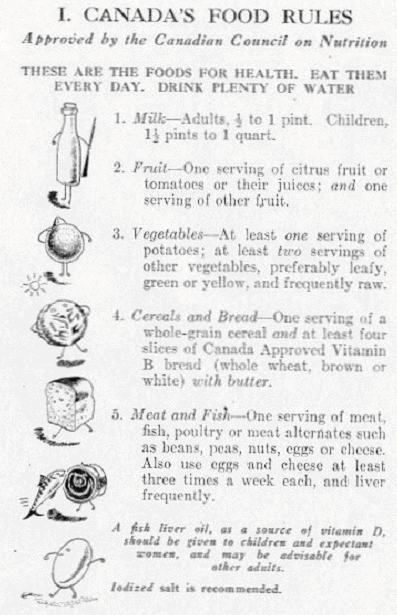
Text Description
This image lists the suggested foods to eat in Canada’s Food Rules. It states:
Canada’s Food Rules
Approved by the Canadian Council on Nutrition.
THESE ARE THE FOODS FOR HEALTH. EAT THEM EVERY DAY. DRINK PLENTY OF WATER.
- Milk- Adults- ½ to 1 pint. Children, 1½ pint to 1 quart.
- Fruit- One serving of citrus fruit or tomatoes or their juices; and one serving of other fruit.
- Vegetables- At least one serving of potatoes. At least two servings other vegetables, preferably leafy, green or yellow, and frequently raw.
- Cereals and bread- One serving of a whole-grain cereal and at least four slices of Canada Approved Vitamin B bread (whole wheat, brown or white) with butter.
- Meat and fish- One serving of meat, fish, poultry or meat alternatives such as beans, peas, nuts, eggs or cheese. Also use eggs and cheese at least three times a week each, and liver frequently.
A fish liver oil, as a source of vitamin D, should be given to children and expectant women, and may be advisable for older adults.
Iodised salt is recommended.
1949 Canada's Food Rules
Nutrition workers from the investigator to the interpreter state that the best way to be well fed is to eat a variety of food.Footnote 14
In 1949, the Canadian Council on Nutrition clarified the Food Rules. Slight changes were made in wording in accordance with the recommendations submitted by the provincial nutritionists. .... [which] "were based on experience gained from using the food rules in their teaching".Footnote 3 Further, the 1949 New Dietary Standard for Canada reflected the expanding knowledge on nutrient requirements and formed the scientific backdrop for certain revisions to Canada's Food Rules. A plea to avoid excess intakes crept into the 1949 Dietary Standard with a strong point that "more" is not necessarily "better". This was partly related to the issue of world scarcity as in previous years, but also in recognition of the fact that excesses may be harmful to individuals in certain circumstances.
The five food groups remained in the 1949 version of the Food Rules, but several changes were made. For example, "at least" was added to the Milk group to accommodate the greater energy needs of some individuals. Bread was no longer limited to Canada Approved Vitamin B bread choices, and the butter reference grew to include "or fortified margarine". The advice about fish oil was replaced with an explicit recommendation for a Vitamin D supplement since dietary surveys of children had uncovered inadequate intakes of this vitamin. The new Rules stated "At least 400 International Units daily for all growing persons and expectant and nursing mothers".
Implementation
The popular Score Sheet for Each Day's Meals was updated, once again in both French and English. It now accommodated a week's worth of meals to allow a person to track progress and compare days. Also, various print sizes of the food guide remained available, including one designed specifically to fit in a standard business envelope, and the Rules appeared in their revised form in several of the publications distributed by the Nutrition Division of the federal government. Most of the previously discussed print material was still available, and a new resource, Canada's Food Rules - A Dietary Framework for All, outlined a day's eating plan for various age groups. The intent of this chart was to encourage greater and more consistent use of Canada's Food Rules.Footnote 15
Canada's Food Rules - 1949
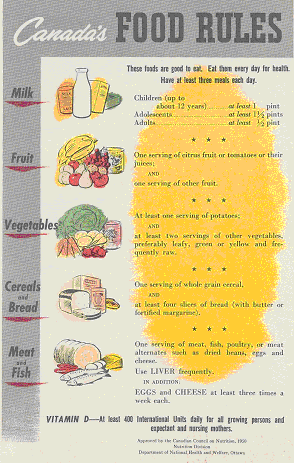
Text Description
This image lists the suggested foods to eat in the 1949 Canada’s Food Rules and states:
These foods are good to eat. Eat them every day for health. Have at least three meals each day.
- Milk: Children (up to about 12 years) - at least 1 pint. Adolescents- at least 1½ pints. Adults- at least ½ pint.
- Fruit: One serving of citrus or tomatoes or their juices and one serving of other fruit.
- Vegetables: At least one serving of potatoes and at least two servings of other vegetables preferably leafy, green or yellow and frequently raw.
- Cereals and bread: One serving of whole grain cereal and at least four slices of bread (with butter or fortified margarine).
- Meat and fish: One serving of meat, fish, poultry or meat alternatives such as dried beans, eggs and cheese. Use liver frequently. In addition, eggs and cheese at least three times a week each.
- Vitamin D: At least 400 International Units daily for all growing persons and expectant and nursing mothers.
Approved by the National Council on Nutrition 1950, Nutrition Division, Department, Department of National Health and Welfare, Ottawa.
A Pattern for Meals - 1949
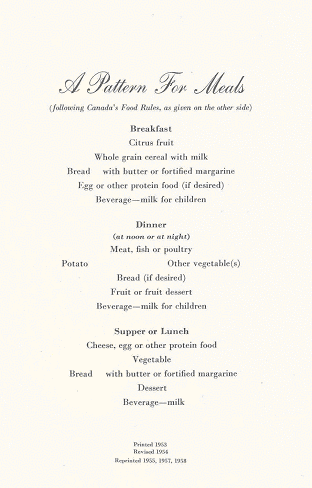
Text Description
This image is the back page of image 3. It states:
A pattern for meals (following Canada’s Food Rules, as given on the other side).
Breakfast: Citrus fruit; whole grain cereal with milk; bread with butter or fortified margarine; egg or other protein food (if desired); beverage-milk for children.
Dinner (at noon or at night): meat, fish or poultry; potato; other vegetable(s); bread (if desired); fruit or fruit dessert; beverage-milk for children.
Supper or lunch: cheese, egg or other protein food; vegetable; bread with butter or fortified margarine; dessert; beverage-milk.
Printed 1953. Revised 1954. Reprinted 1955, 1957, 1958
1961 Canada's Food Guide
There have been changes in methods of food processing, storage, and transportation, which in turn have changed the types of food available to Canadians throughout the year.Footnote 16
In the 1961 version of the food guide, food choices broadened and language softened. "Guide" replaced "Rules" in the title. Canada's Food Guide, still the ubiquitous, easy-to-use leaflet, now stressed its flexibility and wide-ranging application for healthy eating, recognizing that many different dietary patterns could satisfy nutrient needs. The original look of the food guide, complete with grey border and yellow splash, underwent a visual dressing up as the five food groups were arranged into horizontal bars of colour.
The revised guide retained five food groups, although much debate had taken place about reducing it to four. In the end, Vegetables and Fruit remained separate, if for no other reason than because the groupings worked well in teaching.Footnote 16 The Cereals and Bread group was renamed as Bread and Cereals, and the quantity message for bread was discarded. However, the emphasis on whole grain cereal prevailed.
Other small changes occurred. For example, the new guide now listed examples of citrus fruit. The term "at least" was dropped from the Bread and Cereals, Vegetables, and Milk groups. Also, for the first time, the Milk group specified intakes for expectant and nursing mothers. An added statement related to the Meat and Fish group clarified the role of meat alternates - "Eggs, cheese, dried beans or peas may be used in place of meat". Liver began to lose its foothold, as demonstrated by the new statement, "Eat liver occasionally", which replaced "Use liver frequently". Another change was the shift in serving sizes for milk to common household measurements, such as cups, instead of pints. As in previous versions, serving sizes were not provided for the other food groups.
Implementation
The availability of many of the previous support materials continued. The Food Guide was available in leaflet, poster and pamphlet form, with the pamphlet providing details on how to use the Guide. For example, charts on shopping wisely, feeding babies, and meal planning were part of the expanded information. Food group descriptions emphasized the unique nutrient contributions of each group, thereby strengthening the connection between the science base and the food recommendations.
Canada's Food Guide - 1961
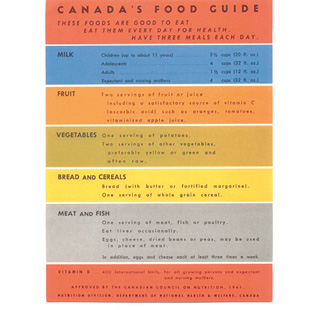
Text Description
This is an image of the 1961 Canada’s Food Guide. At the top it states: These foods are good to eat. Eat them every day for health. Have three meals each day.
A chart with food groups is listed on the left side and recommended servings of food and beverages on the right side. It states:
Milk
- Children up to about 11 years: 2½ (20 fluid ounces)
- Adolescents: 4 cups (32 fluid ounces)
- Adults: 1½ cups (12 fluid ounces)
- Expectant and nursing mothers: 4 cups (32 fluid ounces)
Fruit
- Two servings of fruit or juice, including a satisfactory source of vitamin C (ascorbic acid) such as oranges, tomatoes, and vitaminized apple juice.
Vegetables
- One serving of potatoes. Two servings of other vegetables, preferably yellow or green and often raw.
Bread and cereals
- Bread (with butter or fortified margarine). One serving of whole grain cereal.
Meat and fish
- One serving of meat, fish or poultry. Eat liver occasionally. Eggs, cheese, dried beans or peas may be used in place of meat. In addition, eggs and cheese at least three times a week.
Vitamin D
- 400 International Units, for all growing persons and expectant and nursing mothers.
Approved by the Canadian Council on Nutrition, 1961. Nutrition Division, Department of National Health and Welfare, Canada.
1977 Canada's Food Guide
Canada's Food Guide is an educational tool which, to be applied successfully, requires interpretation.Footnote 18
The dramatic new look of the 1977 Canada's Food Guide sparked much interest. For the first time, colorful pictures of foods were grouped in wheel-like fashion around a sun graphic. This Guide boasted several other innovations in addition to the dynamic design change. For instance, four food groups, instead of five, appeared - fruits and vegetables were combined since their nutrient contributions overlapped. Ranges were added to the serving suggestions, bolstering the flexible nature of the Guide. In addition, metric units made their way into the serving size suggestions to align with Canada's move to the metric system.
More than 30 textual changes occurred with the 1977 revision. For example, the milk group became Milk and Milk Products, paving the way for the inclusion of other dairy food choices. Meat and Alternates replaced Meat and Fish, and a statement regarding the Bread and Cereals group established that "enriched" products could be used in place of whole grain. Further, Fruit and Vegetables were combined into one group, and the recommendation to eat one serving of potatoes was deleted.
The 1977 revision was guided by reports from the Nutrition Canada National Survey (1973)Footnote 19, which represents the largest, most comprehensive nutritional study of the Canadian population to date. Data from the survey reports, in particular the Food Consumption Patterns Report, provided current information on regional and national food choices, significant since earlier food guide revisions had been hampered by the limited knowledge on national food consumption patterns. Similarly, the revision was influenced by a think piece, released in 1974 by the Minister of National Health and Welfare, entitled A New Perspective on the Health of Canadians.Footnote 20 This document provided an insightful analysis of what contributes to health, including the role of good nutrition. The 1977 revision was also influenced by the contributions of many health professional groups and organizations.
Implementation
A second page presented practical information to support implementation of the Guide, such as food choices for each food group. Also, the 1977 version of Canada's Food Guide was supported by the premiere edition of Canada's Food Guide Handbook, considered by many to be a nutrition education milestone. The Handbook explained the concepts underlying the Guide, illustrated examples, and discussed nutrient functions. The handbook remained a staple food guide resource and underwent revisions alongside the next two iterations of Canada's Food Guide.
Canada's Food Guide - 1977 - Front
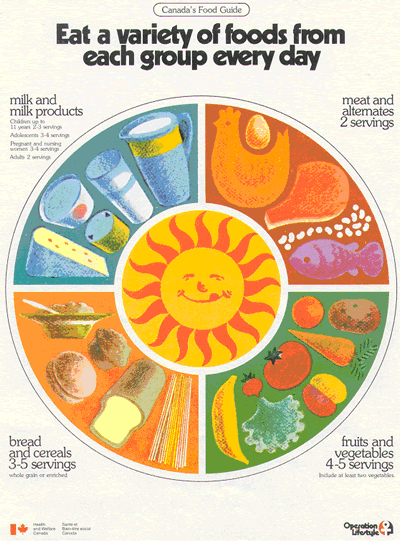
Text Description
This image is the front side of the 1977 Food Guide and depicts a wheel-like image divided in four sections with a sun at the centre. Food groups are depicted around the sun with examples of foods illustrated in each section. The message above the image is:
- Eat a variety of foods from each group every day.
Milk and milk products are depicted in the top left section of the wheel. Foods depicted are milk, canned milk, yogurt and cheese. Messages on the number of servings specific to each age group are:
- Children up to 11 years: 2 to 3 servings.
- Adolescents: 3 to 4 servings.
- Pregnant and nursing women: 3 to 4 servings.
- Adults: 2 servings.
Meat and alternatives are depicted in the top right section of the wheel. Foods depicted are chicken, an egg, a meat cut, legumes and fish. Two servings are recommended.
Bread and cereals are depicted in the bottom left section of the wheel. Foods depicted are pasta, bread, a muffin, a bun and a bowl of cereal. Three to five servings are recommended, specifically whole grain or enriched.
Fruits and vegetables are depicted in the lower right section of the wheel. Foods depicted are a potato, an orange, a carrot, a tomato, an apple, a leaf of lettuce, a banana and a radish. Four to five servings are recommended, including a specification to include at least two vegetables.
Canada's Food Guide - 1977 - Back
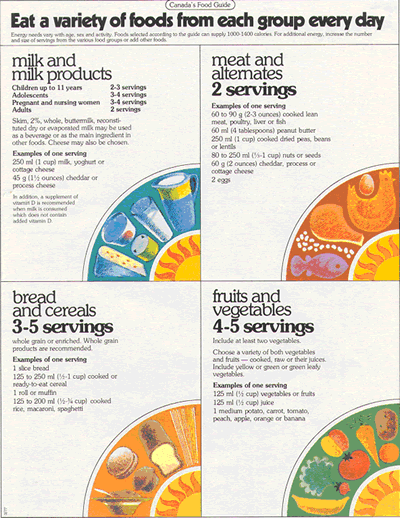
Text Description
This image is the back page of the 1977 Food Guide and provides more specifics for each food group. The following statements are listed at the top of the image:
Eat a variety of foods from each food group every day. Energy needs vary with age, sex and activity. Foods selected according to the guide can supply 1000-1400 calories. For additional energy, increase the number and size of servings from the various food groups or add other foods.
Food groups are divided into four sections below these statements. The illustrations of the food group are included in each of the sections.
On the top left section it states:
- Milk and milk products:
- Children up to 11 years: 2 to 3 servings.
- Adolescents: 3 to 4 servings.
- Pregnant and nursing women: 3 to 4 servings.
- Adults: 2 servings
- Skim, 2%, whole, buttermilk, reconstituted dry or evaporated milk may be used as a beverage or as the main ingredient in other foods. Cheese may also be chosen.
- Examples of one serving
- 250 milliliters (1 cup) milk, yoghurt or cottage cheese
- 45 grams (1½ ounces) cheddar or process cheese
- In addition, a supplement of vitamin D is recommended when milk is consumed which does not contain added vitamin D.
On the top left section it states:
- Meat and alternatives
- 2 servings.
- Examples of one serving
- 60 to 90 grams (2 to 3 ounces) cooked lean meat, poultry, liver or fish
- 60 milliliters (4 tablespoons) peanut butter
- 250 milliliters (1 cup) cooked dried peas, beans and lentils
- 80 to 250 milliliters (1/3 third to 1 cup) nuts or seeds
- 60 grams (2 ounces) cheddar, process of cottage cheese
- Two eggs.
On the bottom left section it states:
- Bread and cereals: 3-5 servings
- Whole grain or enriched. Whole grain products are recommended.
- Examples of one serving
- 1 slice of bread
- 125 to 250 millilitres (1/2 to 1 cup) cooked or ready-to-eat cereal
- 1 roll or muffin
- 125 to 200 millilitres (1/2 to 3/4 cup) cooked rice, macaroni, spaghetti
On the bottom right section it states:
- Fruits and vegetables: 4 to 5 servings.
- Include at least two vegetables.
- Choose a variety of both vegetables and fruits-cooked, raw or their juices. Include yellow or green leafy vegetables.
- Examples of one serving
- 125 milliliters (1/2 cup) of vegetables or fruits
- 125 millilitres (1/2 cup) juice
- 1 medium potato, carrot, tomato, peach, apple, orange or banana
1982 Canada's Food Guide
... after reviewing the information available on the relationship between diet and cardiovascular disease, [the committee] believes that there is an adequate basis for recommending changes in the Canadian diet.Footnote 21
The landmark Report of the Committee on Diet and Cardiovascular DiseaseFootnote 21, submitted to Health Canada in 1977 by an appointed committee of experts, advised the government to take action to prevent diet-related chronic diseases. This Report contributed to the development of four national Nutrition Recommendations for Canadians. In 1977, these recommendations were approved and adopted by many government departments, professional groups, health organizations, and food processors.Footnote 22 The Report and Recommendations, together with findings from an evaluation of the 1977 Food Guide and HandbookFootnote 23, prompted the 1982 revision. In the evaluation, health professionals expressed interest in the integration of the national nutrition recommendations into the Food Guide.
Two significant modifications resulted. While the emphasis on the "variety" message continued, the "energy balance" message was expanded to stress balancing energy intake with energy output. Further, a new "moderation" message appeared. On the surface, the changes appeared to be minor. In fact, they signified a major shift in dietary advice. The previous food guide goals of preventing nutrient deficiencies were now being integrated with the goal of reducing chronic diseases. In particular, the moderation statement, which encouraged Canadians to limit fat, sugar, salt, and alcohol, was an attempt to curb the rising rate of diet-related chronic diseases by influencing eating habits.
The four food groups remained the same. However, the name of the meat group was changed to Meat, Fish, Poultry and Alternates - longer but perhaps more inclusive.
Implementation
The Canada's Food Guide Handbook was revised to support the food guide changes. Sections and chapters expanded to include more on the Nutrition Recommendations for Canadians and the new thrust of dietary advice.
Canada's Food Guide - 1982 - Front
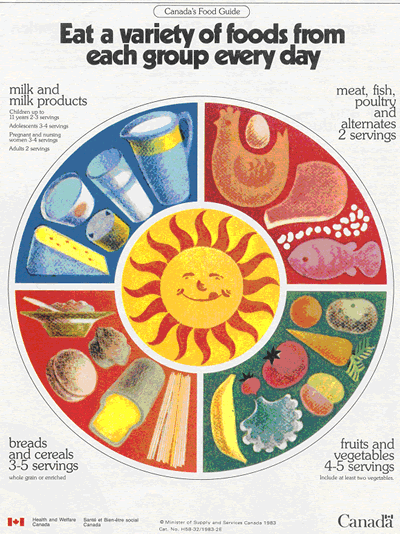
Text Description
The front side of the 1982 Food Guide depicts a wheel-like image with a sun at the centre. Food groups are depicted around the sun in four sections. Above the sun it states:
Eat a variety of foods from each group every day.
Milk and milk products are depicted in the top left section of the wheel. Foods depicted are milk, canned milk, yogurt and cheese. Messages on the number of servings specific to each age group are:
- Children up to 11 years: 2 to 3 servings
- Adolescents: 3 to 4 servings
- Pregnant and nursing women: 3 to 4 servings
- Adults: 2 servings
Meat, fish, poultry and alternatives are depicted in the top right section of the wheel. Foods depicted are chicken, an egg, a meat cut, legumes and fish. Two servings are recommended.
Breads and cereals are depicted in the bottom left section of the wheel. Foods depicted are pasta, bread, a muffin, a bun and a bowl of cereal. Three to five servings are recommended, specifically whole grain or enriched.
Fruits and vegetables are depicted in the lower right section of the wheel. Foods depicted are a potato, an orange, a carrot, a tomato, an apple, a leaf of lettuce, a banana and a radish. Four to five servings are recommended, including a specification to include at least two vegetables.
Canada's Food Guide - 1982 - Back
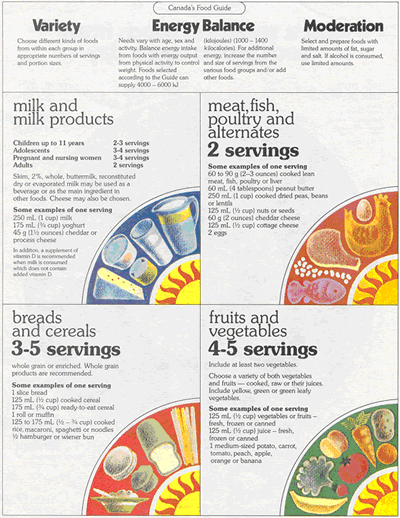
Text Description
The back page of the 1982 Food Guide provides messages related to variety, energy balance and moderation, as well as specific information for each food group.
At the top left corner it states:
- Variety
- Choose different kinds of foods from within each group in appropriate numbers of servings and portion sizes.
At the top centre of the image it states:
- Energy balance
- Needs vary with age, sex and activity to control weight. Foods selected according to the Guide can supply 4000-6000 kJ (kilojoules) (1000-1400 kilocalories). For additional energy, increase the number of servings from the various food groups and/or add other foods.
At the top right side it states:
- Moderation
- Select and prepare foods with limited amounts of fat, sugar and salt. If alcohol is consumed, use limited amounts.
Illustrated examples of food and beverages on included in each of the four sections.
In the top left section it states:
- Milk and milk products
- Children up to 11 years: 2 to 3 servings
- Adolescents: 3 to 4 servings
- Pregnant and nursing women: 3 to 4 servings
- Adults: 2 servings.
Skim, 2%, whole, buttermilk, reconstituted dry or evaporated milk may be used as a beverage or as the main ingredient in other foods. Cheese may also be chosen.
Some examples of one serving
- 250 milliliters (1 cup) milk
- 175 milliliters (3/4 cup) yoghurt
- 45grams (1½ ounces) cheddar or process cheese.
In addition, a supplement of vitamin D is recommended when milk is consumed which does not contain added vitamin D.
In the top right section it states:
- Meat, fish, poultry and alternatives
- 2 servings
- Some examples of one serving
- 60 to 90 grams (2 to 3 ounces) cooked lean meat, fish, poultry or liver
- 60 milliliters (4 tablespoons) peanut butter
- 250 milliliters (1 cup) cooked dried peas, beans and lentils
- 125 milliliters (half cup) nuts or seeds
- 60 grams (2 ounces) cheddar cheese
- 125 milliliters (half cup) cottage cheese
- 2 eggs
In the bottom left section it states:
- Breads and cereals
- 3 to 5 servings
- Whole grain or enriched. Whole grain products are recommended.
- Some examples of one serving
- 1 slice of bread
- 125 millilitres (1/2 cup) cooked or ready-to-eat cereal
- One roll or muffin
- 125 to 175 millilitres (1/2 to ¾ cup) cooked rice, macaroni, spaghetti or noodles
- ½ hamburger of wiener bun
In the bottom right section it states:
- Fruits and vegetables
- 4 to 5 servings
- Include at least two vegetables.
- Choose a variety of both vegetables and fruits − cooked, raw or their juices. Include yellow, green or green leafy vegetables.
- Some examples of one serving
- 125 milliliters (1/2 cup) vegetables or fruits – fresh, frozen or canned
- 125 millilitres (1/2 cup) juice – fresh, frozen or canned
- 1 medium-sized potato, carrot, tomato, peach, apple, orange or banana
1992 Canada's Food Guide to Healthy Eating
The revised Canada's Food Guide... marks a new era in nutrition guidance in Canada.Footnote 24
Historic changes accompanied the 1992 revision. The title was changed to reflect the overarching goal of the Guide, becoming Canada's Food Guide to Healthy Eating. The design changed - a rainbow graphic now displayed the four food groups, all of which bore new names: - Grain Products, Vegetables and Fruit, Milk Products, and Meat and Alternatives. The biggest change was a shift in the philosophy of the Food Guide in that the 1992 Guide embraced a total diet approach to choosing foods. Previous food guides were based on a foundation diet concept - they identified minimum requirements, necessitating those with higher needs to self-select more food. The total diet approach aimed to meet both energy and nutrient requirements, recognizing that energy needs vary. With the total diet approach came large ranges in the number of servings from the four food groups to accommodate the wide range of energy needs for different ages, body sizes, activity levels, genders and conditions such as pregnancy and nursing. The Guide also introduced the Other Foods category which included foods and beverages that did not fit into any of the four food groups and, although part of the diets of many Canadians, would traditionally not have been mentioned in a food guide.
To meet higher energy needs, the rainbow schematic encouraged selection of more servings from the Grain Products and Vegetables and Fruit groups, a concept that was graphically presented through larger bands of the rainbow compared to those used to illustrate the Milk Products and Meat and Alternatives groups. The 1992 Food Guide also introduced the notion of directional statements to give more guidance on choosing foods.
The process to develop the 1992 Guide was considered to be revolutionary in food guide history. Information was assembled from experts, consumers, literature reviews, food consumption surveys, consumer research, and commissioned scientific reviews. Consultation was an integral part of the process.
Implementation
A number of Food Guide materials were created, the most popular being the Canada's Food Guide to Healthy Eating tearsheet. A 16-page booklet intended to help consumers to understand and use the Food Guide was also developed. In addition, Food Guide Facts - Background for Educators and Communicators was developed to assist educators in teaching and disseminating information about the Guide. Two additional resources were produced to help educators and communicators use Canada's Food Guide to promote healthy eating among preschool children aged two to five years, and children aged 6 to 12 years. As in earlier days, resources were developed in both French and English. An important change was the availability of the Food Guide and its accompanying support materials through the internet. In fact, Canada's Food Guide to Healthy Eating consistently was the most popular destination on the Health Canada Web site.
Canada's Food Guide to Healthy Eating - 1992 - Front
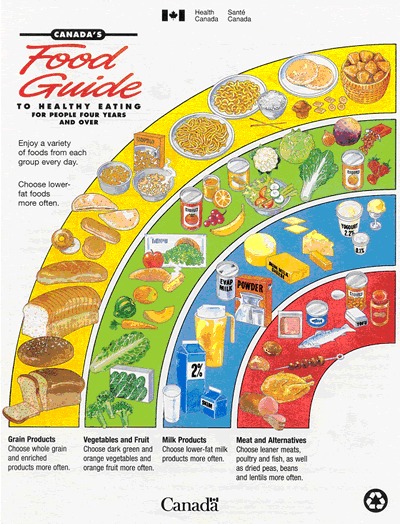
Text Description
The front side of Canada’s Food Guide 1992 includes a rainbow with four arcs each representing a food group with images of foods and key messages.
On the top left it states:
- Canada’s Food Guide to healthy eating for people four years and over
Two key messages appear beside the rainbow:
- Eat a variety of foods from each food group every day.
- Choose lower-fat foods more often.
The largest arc of the rainbow is yellow and represents the Grain products food group. Foods depicted include a variety of breads (for example, pita bread and whole wheat bread), hot and cold cereals, pastas, rice and baked goods such as a muffin and pancakes.
At the bottom of the arc it states:
- Choose whole grain and enriched products more often.
The second largest arc of the rainbow is green and represents the Vegetables and Fruit group. Foods depicted include fresh vegetables such as broccoli, leafy vegetables and a salad, fresh fruit such as an apple, a banana and berries. It also includes frozen vegetables, canned vegetables and fruits, orange juice and dried fruit.
At the bottom of the band it states:
- Choose dark green and orange vegetables and orange fruit more often.
The third arc of the rainbow is blue and represents the Milk Products food group. Foods depicted include fresh, powdered and canned milk, cheeses, yogurts and ice cream.
At the bottom of the arc it states:
- Choose lower-fat milk products more often.
The fourth and smallest rainbow band is red and represents the Meat and Alternatives food group. The foods depicted include processed meats, cooked turkey, different types of red meat, fresh and canned fish, tofu, an egg, canned beans and a peanut butter jar. At the bottom of the band it states: Choose leaner meats, poultry and fish, as well as dried peas, beans and lentils more often.
Canada's Food Guide to Healthy Eating - 1992 - Back
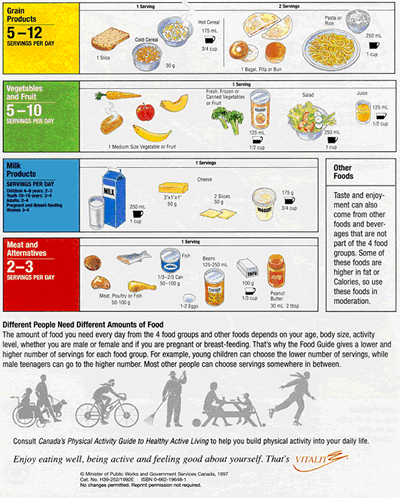
Text Description
The back page of the 1992 Food Guide provides specific numbers of servings and serving sizes for each food group.
Grain products: 5 to 12 servings per day. Examples of one serving are 1 slice of bread; 30 grams of cold cereal and; 175 millilitres (3/4 cup) of hot cereal. Examples of two servings are one bagel, pita or bun; 250 millilitres (1 cup) of pasta or rice.
Vegetables and fruit: 5 to 10 servings per day. Examples of one serving are one medium size vegetable or fruit such as an apple or a carrot; 125 millilitres (1/2 cup) of fresh, frozen or canned vegetables or fruit; 250 millilitres (1 cup) of salad or; 125 milliliters (1/2 cup) of juice.
Milk Products: Children 4 to 9 years: 2 to 3 servings per day. Youth 10 to 16 years: 3 to 4 servings per day. Adults: 2 to 4 servings per day. Pregnant and breastfeeding women: 3 to 4 servings. Examples of one serving are 250 millilitres (1 cup); 50 grams of cheese, equivalent to a piece measuring 3 inches by 1 inch by 1 inch or 2 slices of processed cheese; 175 milliliters (3/4 cup) of yogurt.
Meat and alternatives: 2-3 servings per day. Examples of 1 serving are 50 to 100 grams of meat, poultry or fish, including canned fish (equivalent to 1/3 to 2/3 of a can); 1-2 eggs; 125 to 250 millilitres of canned beans; 100 grams (1/3 cup) of tofu; 30 millilitres (2 tablespoons) of peanut butter.
Other foods: Taste and enjoyment can also come from other foods and beverages that are not part of the four food groups. Some of these foods are higher in fat or Calories, so use these foods in moderation.
The section at the bottom of the page is titled:
Different people need different amounts of food.
The content is:
The amount of food you need every day from the four food groups and other foods depends on your age, body size, activity level, whether you are male or female and if you are pregnant or breast-feeding. That’s why the Food Guide gives a lower and higher number of servings for each food group. For example, young children can choose the lower number of servings, while male teenagers can go to the higher number. Most other people can choose servings somewhere in between.
Below this content are five silhouettes of people doing different types of physical activity. On the left there is a person in a wheel chair next to a person walking a dog. Next to this is a person riding a bicycle, then a person racking leaves, then two people at a picnic table with a baseball bat and ball, and then person ice skating on the far right.
Underneath these silhouettes is the following message:
Consult Canada’s Physical Activity Guide to Healthy Active Living to help you build physical activity into your daily life.
The following tagline appears at the bottom:
Enjoy eating well, being active and feeling good about yourself. That’s Vitality.
2007 Eating Well with Canada's Food Guide
Eating Well with Canada's Food Guide
In 2007 a revised Food Guide was released with many new features and a new title - Eating Well with Canada's Food Guide.
Rationale for Food Guide revisions
The revisions to the Food Guide were based on several factors:Footnote 25Footnote 26
- Updated nutrient reference values for healthy populations through the Dietary Reference Intake (DRI) reports.
- Rising rates of nutrition-related chronic illness and a scientific review of the association with food choices.
- Findings from extensive consultation with a range of stakeholders regarding the 1992 Food Guide and related support tools.
- Extensive food pattern modeling to evaluate various age-and gender-specific food patterns relative to the DRI nutrient standards.
- Focus testing of Eating Well with Canada's Food Guide, the Food Guide website and resources for educators and communicators.
- An evolving food supply and the ever-changing environment that affects the lifestyles of Canadians and their food choices.
Three Advisory Groups provided guidance and advice throughout the revision process – the DRI Expert Advisory Committee, an Interdepartmental Working Group and the Food Guide Advisory Committee.
New features of Eating Well with Canada's Food Guide
Designed as an "all-in-one tool," the 2007 version of the Food Guide addressed some of the challenges identified in the 1992 Guide while building on its strengths of flexibility, simplicity, visual appeal, wide-spread awareness and consistency with current science.Footnote 25
Features of the 2007 Food Guide included:
- A new format as a six-page fold-out booklet.
- The Vegetables and Fruit food group positioned as the most prominent arc in the rainbow design, representing the important role that this group plays in a healthy eating pattern.
- More guidance on the quality of food choices that focuses on risk reduction for chronic illness and obesity while meeting nutrient requirements for most Canadians.
- Food intake patterns for nine age and sex groups, providing specific guidance on number of servings for children over 2 years, adults over 50 years, and women (pregnant, breastfeeding and those who could become pregnant).
- The name of the Milk Products group changed to Milk and Alternatives to acknowledge other food sources of calcium such as fortified soy beverage for non-milk drinkers.
- Guidance on the amount and type of added oils and fats to consume. Encourages the reduction in trans fats and the replacement of saturated with unsaturated fats.
- For Canadians over age 50 a daily vitamin D supplement recommended.
- Encourages regular physical activity as a benefit along with eating well.
- A tailored Food Guide for First Nations, Inuit and Métis people recognizing the importance of both traditional and store-bought foods in contemporary food patterns of Aboriginal people.
- A greater variety and more ethnically diverse choices of foods pictured in print and web-based resources.
- Specific information on using the food label to choose healthy foods.
Eating Well with Canada’s Food Guide – First Nations, Inuit and Métis
In 2007, for the first time, Canada's Food Guide was tailored nationally to reflect First Nations, Inuit and Métis food and traditions. Eating Well with Canada's Food Guide – First Nations, Inuit and Métis was developed to complement Eating Well with Canada's Food Guide, and to recognize the importance of traditional and store-bought food in the diet of Indigenous peoples.
Guidance and advice throughout the development of this food guide was provided by an advisory group, nutrition educators who promote healthy eating with First Nations, Inuit and Métis (FNIM) as well as FNIM community members.
During the development of this guide, stakeholders relayed that depicting traditional food would be important. Traditional food consumption, even with small amounts consumed, improves the quality of the diet for several nutrients. Traditional food also holds significant spiritual and cultural significance.
Some key features of the Eating Well with Canada’s Food Guide – First Nations, Inuit and Métis included:
- Emphasis on the diversity of traditional food for First Nations, Inuit and Métis.
- Inclusion of traditional food from across Canada, including food from lakes, rivers, and the ocean, such as fish, clams and other shellfish as well as berries, wild rice, wild green plants and legumes such as beans.
- A depiction of store-bought foods that are generally available even in rural and remote locations.
- A guideline for how traditional foods can be used in combination with store-bought foods for a healthy eating pattern.
Just as in Eating Well with Canada’s Food Guide, this tailored First Nations, Inuit and Métis food guide provided guidance on the amounts and types of food needed and on the importance of being physically active every day.
Implementation
To support implementation, the 2007 Food Guide was translated into 10 different languages in addition to English and French. The tailored Food Guide for First Nations, Inuit and Métis was translated into Cree, Ojibwe (Anishinaabe) and Inuktitut in addition to English and French. A significant Internet component was developed with many resources and interactive tools such as:
- My Food Guide – allowed users to personalize Food Guide information based on age, sex, food preferences and activity choices.
- My Food Guide Mobile App.
- My Food Guide – Questions and Answers for Educators.
- My Food Guide Servings Tracker.
- Eat Well Plate.
- Eating Well With Canada's Food Guide – A Resource for Educators and Communicators.
- Eat Well and Be Active Educators' Toolkit includes posters, images, ready-to-go presentations and activity plans.
- Nutrition Labelling Educator Section.
- Interactive Nutrition Labelling Quiz.
- Ready-to-Use Presentations.
Eating Well with Canada's Food Guide
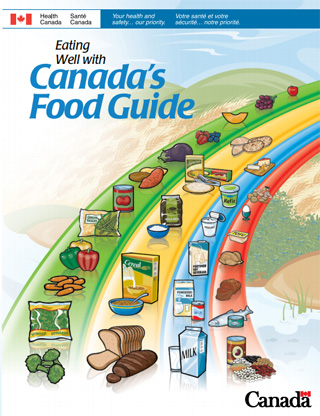
Text Description
This image of the 2007 Food Guide represents the front page of the food guide and says Eating Well with Canada’s Food Guide at the top left corner.
There is a rainbow with four arcs representing the four food groups. The left and largest arc of the rainbow includes illustrated examples of fresh, frozen and canned vegetables and fruit. The next arc is smaller and includes illustrated examples of grain products. A smaller arc next to this includes illustrated examples of milk and milk products. The arc on the right of the three others is the smallest and includes illustrated examples of meat and alternatives.
Eating Well with Canada's Food Guide
Eating Well with Canada's Food Guide – First Nations, Inuit, and Métis
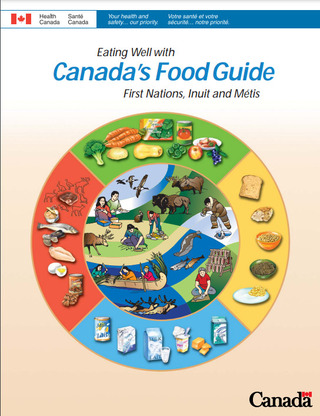
Text Description
This image represents the front page of the 2007 Eating Well with Canada’s Food Guide – First Nations, Inuit and Métis version.
The image contains an outer circle and an inner circle. A circular design is meaningful to many Indigenous cultures, representing balance, cycles of life and nature. The outer circle is divided in 4 parts, with the colours of the four food groups represented and examples of store-bought foods and some traditional food included. The top portion of the circle includes illustrated examples of fresh, frozen, canned and harvested vegetables and fruit. The right portion includes illustrated examples of grain products. The bottom portion includes illustrated examples of milk and alternatives. The left portion includes illustrated examples of meat and alternatives including game meat. The inner circle illustrates examples of traditional food gathering activities and promotes physical activity. This image relays the cultural, spiritual, emotional and physical significance of traditional food, demonstrating the link of food to land, culture, traditions, family and community.
Eating Well with Canada’s Food Guide – First Nations, Inuit and Métis
Conclusion
In some ways, the food guide that we use today (released in 2019) has evolved and is quite different from the 1942 Canada's Official Food Rules. In other ways, it is not. The same intent underlies all of the guides between 1942 and the present version: guiding food selection to promote the nutritional health of Canadians.
References
- Footnote 1
-
Morrell, C.A. (1963). Looking back over 25 years at the Canadian council on nutrition. Canadian Nutrition Notes, 49-54.
- Footnote 2
-
Murray, T.K. (1983). Canadian dietary standards - past and present. Prevention Preview, 4(2):1,6.
- Footnote 3
-
Canadian Council on Nutrition. (1949). A New Dietary Standard for Canada.
- Footnote 4
-
Pett, L.B. Food makes a difference. Can J Public Health, 1942: 565-570.
- Footnote 5
-
Canadian Council on Nutrition. (1943). Minutes, 8th meeting. March 29 (cited in Health and Welfare Canada. Action towards healthy eating: technical report. 1990).
- Footnote 6
-
Nutrition Division, National Department of Health and Welfare (1961). Rules out - guide in. Canadian Nutrition Notes, 17(7):49-50 (cited in Health and Welfare Canada. Action towards healthy eating: technical report. 1990).
- Footnote 7
-
Ballantyne, R.M. (1977). Canada's Food Guide - Revised. Journal of the Canadian Dietetic Association, 38:183-186 (cited in Health and Welfare Canada. Action towards healthy eating: technical report. 1990).
- Footnote 8
-
Health and Welfare Canada. (1990). Action towards healthy eating: technical report.
- Footnote 9
-
Dominion of Canada. (1943). Report of the work of the department of pensions and national health.
- Footnote 10
-
Anon. (1944). Memorandum on Canada's Official Food Rules Revision, May 8 (cited in Health and Welfare Canada. Action towards healthy eating: technical report. 1990).
- Footnote 11
-
Canadian council on Nutrition. (1944). Minutes, 9th meeting. May 8-9 (cited in Health and Welfare Canada. Action towards healthy eating: technical report. 1990).
- Footnote 12
-
Canadian Council on Nutrition. (1945). Minutes, 10th meeting, June 8-9 (cited in Health and Welfare Canada. Action towards healthy eating: technical report. 1990).
- Footnote 13
-
Nutrition Division, Department of National Health and Welfare (1946). Canada's food rules. Canadian Nutrition Notes, 2(7):1-3.
- Footnote 14
-
Nutrition Division, National Department of Health and Welfare. (1950). Practically speaking. Canadian Nutrition Notes, 7(2):11.
- Footnote 15
-
Nutrition Division, National Department of Health and Welfare. (1952). Canada's food rules - a dietary framework for all. Canadian Nutrition Notes, 8(3):19-20.
- Footnote 16
-
Nutrition Division, National Department of Health and Welfare. (1961). Rules out - guide in. Canadian Nutrition Notes, 17(7):49-50
- Footnote 17
-
Department of National Health and Welfare. (1967). Good Food Good Health: Do you follow Canada's Food Guide?
- Footnote 18
-
Nielsen, H. (1977). Canada's food guide - revised, 1977. Presentation to the Canadian Dietetic Association.
- Footnote 19
-
Health and Welfare Canada. Nutrition Canada: National Survey. (1973). Ottawa: Information Canada.
- Footnote 20
-
Lalonde, M. (1974). A new perspective on the health of Canadians. Government of Canada.
- Footnote 21
-
Health and Welfare Canada (1976). Report of the committee on diet and cardiovascular disease.
- Footnote 22
-
Beare-Rogers, J.L. (1984). Dietary goals and recommendations in Canada. J Can Dietetic Association, 45(4):325-335.
- Footnote 23
-
Ballantyne, R.M., Bush, M.B. (1980). An evaluation of Canada's food guide and handbook. Nutrition Quarterly, 4(1):1-4.
- Footnote 24
-
Connolly, C. (1992). A new era in nutrition guidance in Canada. Rapport, 7(4):4-5.
- Footnote 25
-
Bush MAA, Martineau C, Pronk JA and Brulé D. Eating Well with Canada's Food Guide: "A Tool for the Times." Canadian Journal of Dietetic Practice and Research 2007; 68 (2): 92-96.
- Footnote 26
-
Katamay SW, Esslinger KA, Vigneault M, Johnston JL, Junkins BA, Robbins LG, Sirois IV, Jones-McLean EM, Kenned AF, Bush MAA, Brulé D, Martineau C. (2007) Eating Well with Canada's Food Guide (2007): Development of the Food Intake Pattern. Nutrition Reviews, 65(4): 155-166.
Page details
- Date modified: